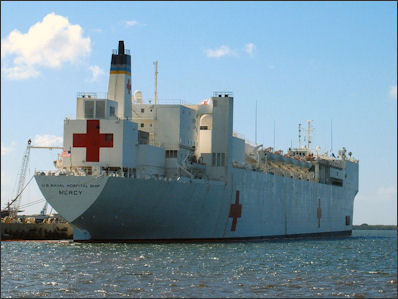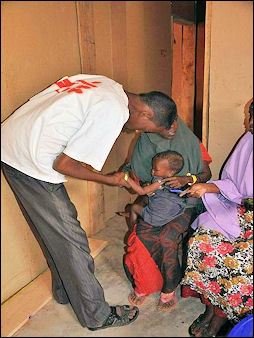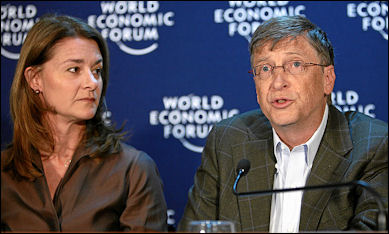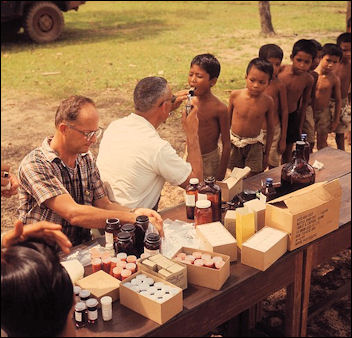DEVELOPMENT ORGANIZATIONS

Red Cross USNS Mercy There are a lot of aid and relief organizations: CARE, the Red Cross, and the Catholic Relief Organization, World Vision. Oxfam is Britain’s largest aid group. There are even workers for veterinarian organizations roaming from village to village in four-wheel-drive vehicles inoculating pigs. Collectively these groups are often called non-governmental organizations (NGOs). Governmental organizations include USAID and the Peace Corps.
CARE is based in Atlanta, Georgia. It has long-term aid programs in 70 nations and has 20 emergency response teams that can be rapidly deployed to a crisis for six to 10 weeks. These teams are made up of specialists in logistics, information management, government relations and other disciplines and follow rules outlined in CARE’s “Emergency Toolkit”. In its long-term projects, these days it is trying to do more to help farmers grow crops and find markets for their products rather than just supply food aid. It also trying to make its programs more business-like and profitable so it isn’t so reliant on donors and governments for funds.
Increasingly, foreign aid workers are the targets of violence. Even though they have little money and are often in trouble spots to help people affiliated with groups that target them they have been victims of murder, kidnaping and robbery. Some aid workers have "run bags," with important medicines and big books, in case they have to make a quick get away or are kidnaped. Some countries have become so dangerous that NGOs deem it too risky to send their people there.
Red Cross

Original Geneva Conventions The Red Cross was founded in 1864 to take care of war casualties by Swiss banker Jean Henri Dunant who was appalled by the Battle of Solferino in the Italian War of 1859, where he helped organize volunteers to help wounded and dying soldiers.
The Red Cross was created as part of the Geneva Convention of 1864, when rules regarding the treatment of wounded soldiers and prisoners of war were also established. Dunant played a major role in getting the first the first world conference, the Geneva Convention, organized in 1863, where it was first proposed that volunteer aid agencies be set up in every country to train health care people in times of peace and help victims in wartime. The red cross on a white background (the Swiss nation emblem reversed) was adopted in honor of Dunant's Swiss nationality.
One of the forces behind the founding of the Red Cross was an English nurse named Florence Nightingale, who made a name for herself helping French, British and Turkish soldiers in the Crimean War against Russia. Descriptions of her experiences helped overcome doubts raised by many that spies could disguise themselves as Red Cross civilian volunteers.
The purpose of the Red Cross was to secure neutrality for doctors, nurse and hospital and Geneva was selected as the home of the philanthropic organization because of Switzerland neutral status.
The International Red Cross embraces national Red Cross societies that operate independently but communicate with one another through the Geneva-based Legaue of Red Cross Societies. In Muslim countries, there is the Red-Cross-like aid organization, the Red Crescent.
Médecins Sans Frontières (Doctors without Frontiers)

MSF health worker examines a malnourished child Probably the most elite organization is Médecins Sans Frontières (MSF, "Doctors without Frontiers"), a group famous for its work in politically troubled spots like Rwanda, Bosnia and Somalia. Awarded a Nobel Peace Prize in 1999, it is involved in a wide range of projects, including everything from performing major surgery on mine victims to experimenting with medication-laced granola bars to inoculate children and families fearful of needles.
Describing conditions in which MSF doctors work Philip Gourevitch wrote in The New Yorker, “In May of 1996, in the hill town of Kitchanga in the North Kivu province of eastern Congo (then still called Zaire), I spent a night in a dank schoolroom that had been temporarily set up as an operating room by surgeons from the Dutch section of Médecins Sans Frontières. A few days earlier, a gang from the U.N.-sponsored refugee camps for Rwandan Hutus — camps that were controlled by the killers, physically, politically, economically — had massacred a group of Congolese Tutsis at a nearby monastery. Members of the M.S.F. team had been patching up some of the survivors. A man with a gaping gunshot wound writhed beneath the forceps of a Belarusian doctor, chanting quietly—“Ay yay, yay, yay, yay, yay” — before crying out in Swahili, “Too much sorrow.” [Source: Philip Gourevitch, The New Yorker, October 11, 2010]
"During my night at the schoolroom surgery in Kitchanga, the doctors told me about a teen-age boy who had been found naked except for a banana leaf, which he had plastered over the back of his head and shoulders. When the leaf fell away, the doctors saw that the boy’s neck had been chopped through to the bone. His head hung off to the side. I saw the boy in the morning. He was walking gingerly around the schoolyard. The doctors had reassembled him and stitched him back together. And he was not the only one they had saved. This was the humanitarian ideal in practice — pure and unambiguous. Such immense “small mercies” are to be found everywhere that humanitarians go, even at the scenes of their most disastrous interventions. What could be better than restoring a life like that? The sight of that sewed-up boy was as moving as the abuses of the humanitarian international were offensive. Then, later that day, the doctors I was travelling with told me that, to insure their own safety while they worked, they had to prove their neutrality by tending to génocidaires as well as to their victims. And I wondered: If these humanitarians weren’t here, would that boy have needed them?" [Ibid]
Bill and Melinda Gates Foundation

Bill and Melinda Gates Perhaps the biggest player these days is the Bill and Melinda Gates Foundation. The Bill & Melinda Gates Foundation, established up by Microsoft billionaire Bill Gates and his wife Melinda, was set up with an endowment of around $30 billion — more than the gross national product of Tanzania — primarily to get rid of some of the world’s most devastating diseases and tackle world health issues . The foundation became worth around $60 billion when Warren Buffet donated $30 billion. It is expected to be worth around $100 billion when the Gates donate the bulk of the remainder of their wealth to it.
Much of the money is earmarked for battling well known diseases such as AIDS, malaria and tuberculosis but some is also being allocated to help lesser known diseases such as Guinea worm disease, lymphatic filariasis, schistosomiasis, river blindness, trypanosomiasis and cysticercosis. The foundation is sometimes criticized for its emphasis on technology, science and developing new vaccines, drugs and treatments rather than on improving the basic health of the poor, educating doctors and scientists in the developing world, and distributing drugs to people who need them.
The Gates Foundations is also committed what is described as the Grand Challenge, 14 obstacles that need be overcome to significantly improve world health. Among the goals ate developing vaccines that don’t need needles or refrigeration.
As of 2005, the Gates Foundations had donated $6 billion to fight global health problems. Gates Foundations donations have including $125 million for the Children’s Vaccine Program; $750 million to the United Nations’s Global Alliance for Vaccine and Immunization, to fight preventable diseases such as measles, diphtheria and whopping cough; $200 million for the Grand Challenges; It spent $88 million on global health in 2005.
The Gates Foundations has become a bigger player in world health than any other organization, charity or even government. The Gates donations of $6 million is also almost four times the World Health organization budget of $1.65 billion. It treats recipients as business partners, auditing their performance and demanding that they contribute what they can to the projects. Governments, no mater how strapped, have to increase their own spending to qualify for funding.
Impact of the Bill and Melinda Gates Foundation on Fight Disease in the Developing World

William H Gates Senior in New-Delhi Health and health care in the developing world has improved greatly with the input of hundreds of millions of dollars from the Bill and Melinda Gates Foundation and NGOs, governments and drug companies that have joined their efforts. A study by the London School of Economics and Political Science found that only 13 drugs targeting neglected diseases were released between 1975 and 2000 but 13 new drugs were launched but in 2004 alone after Gates money arrived on the scene and 63 projects to develop such drugs were underway.
Bill Gates wrote in Newsweek in 2007, “When Melinda and I started our foundation, we would go to sub-Sahara Africa or developing countries in other regions and see health workers struggling with broken equipment and empty medicine chests. We walked down dirty hallways packed with exhausted mothers holding sick children, In those days, many took it as inevitable that millions of poor people would die each year from diseases that are preventable, treatable and no longer present in the developed world. That’s starting to change. Today governments, aid groups and communities are simply refusing to accept the notion that diseases like malaria and tuberculosis will haunt is forever. The evidence is in: these problems can be solved.”
One of the goals of the foundation is to develop vaccines and treatments that are cheap enough for public health institutions to distribute, eliminating the dependance on wealthy donors. “Millions have been saved through better financing and delivery of the medical advances available today, Gates wrote. “I believe we stand at a moment of unequaled opportunity. Governments must step up to the plate with more money — wisely targeted — to expand effective global health programs to reach all those in need. Businesses, community groups and individuals all play a role as well....I’m now convinced more than ever that we can create a healthier world for everyone.”
Japanese Housewife-Run NGO

Thai village children examined by
members of U.S. Air Force Nippon International Cooperation for Community Development (NICCO) is a Kyoto-based organization established in 1979 by Japanese homemakers and students to support Cambodian refugees. In 2011 it was awarded the 18th Yomiuri International Cooperation Prize for employing unusual training methods such as teaching farmers how to use human waste as fertilizer. [Source: Asako Kisui, Yomiuri Shimbun, October 26, 2011]
NICCO was founded by Satoyo Ono. In 1979, while working as volunteer helping foreign students in Kyoto, she was told by a Cambodian student one day: "I can't contact my family. I want to help people in my home country." Few international cooperation organizations existed in Japan at the time. Despite her lack of experience in this field, Ono called on homemakers and students to support the Cambodian people. They established the Kampuchean Refugee Relief Program in December 1979. Ono collected donations on the street to help Cambodian refugees, and in March 1980, she visited a Cambodian refugee camp on the border of Thailand and Cambodia.
U.N. organizations and other international bodies provided enough food to keep the refugees alive. Ono feared the refugees would become accustomed to receiving international aid and lose the motivation to work once peace was restored in their country. Ono encouraged the leader of the refugee camp to "gain pleasure through work" and launched a program to have refugees operate a poultry farm and make textiles and pottery. Ono's group provided materials needed for the program. After the program moved into full gear, Ono asked the local people to repay the cost of materials supplied. The refugees became more industrious as their income rose.After Ono's activities in Cambodia became well known, the group received requests from Southeast Asian nations, including Thailand and Laos, to help people there. In 1988, Ono's group changed its name to NICCO.
NICCO participated in a project to deliver medicine to Iraq in 1991 during the Gulf War, and the organization's activities spread to other Middle East and African nations. One major NICCO success story took place in the Republic of Malawi, one of the world's poorest countries, located in southern Africa.

EU food aid When people in that country suffered a famine brought on by drought in 2005, NICCO urgently delivered seeds for corn, their staple food. However, the land was infertile and farmers could not afford to buy chemical fertilizer.In response, NICCO introduced the "ecological sanitation toilet," which converts human waste into safe and effective fertilizer, in 2007.
NICCO organization has developed its activities in 19 countries over the past 32 years. Its major objective it to foster self-reliance through such projects as teaching women in Palestine, where NICCO has been active since 2007, to make soap to earn income. They have also provided emergency support after such natural disasters as earthquakes and floods in 13 countries.Ono said she wanted people to overcome difficulties and become happy. "It's best if the time comes when people will say, 'We don't need NICCO any more,'" she said.
World Food Program, OECD and FAO
The Rome-based U.N. World Food Program is the world’s largest humanitarian organization. It was set up in the 1950s to distribute surplus U.S. and European food. The Rome-based U.N. Food and Agriculture Organization ( FAO) has been criticized for being out of touch with today’s realities and problems.
The Organization of Economic Cooperation and Development (OECD) was founded after World War II to oversee the Marshall Plan. It has struggled in recent years with budget cuts and lack of purpose. Based in Paris, it is made up of rich industrialized, with the United States and Japan each paying a quarter of its biggest, but also includes Turkey and the Slovak Republic among its members. It is perhaps best known for its economic analysis and promoting good behavior among its 34 members.
Image Sources: Wikimedia Commons
Text Sources: New York Times, Washington Post, Los Angeles Times, Times of London, Yomiuri Shimbun, The Guardian, National Geographic, The New Yorker, Time, Newsweek, Reuters, AP, Lonely Planet Guides, Compton’s Encyclopedia and various books and other publications.
Last updated January 2012
